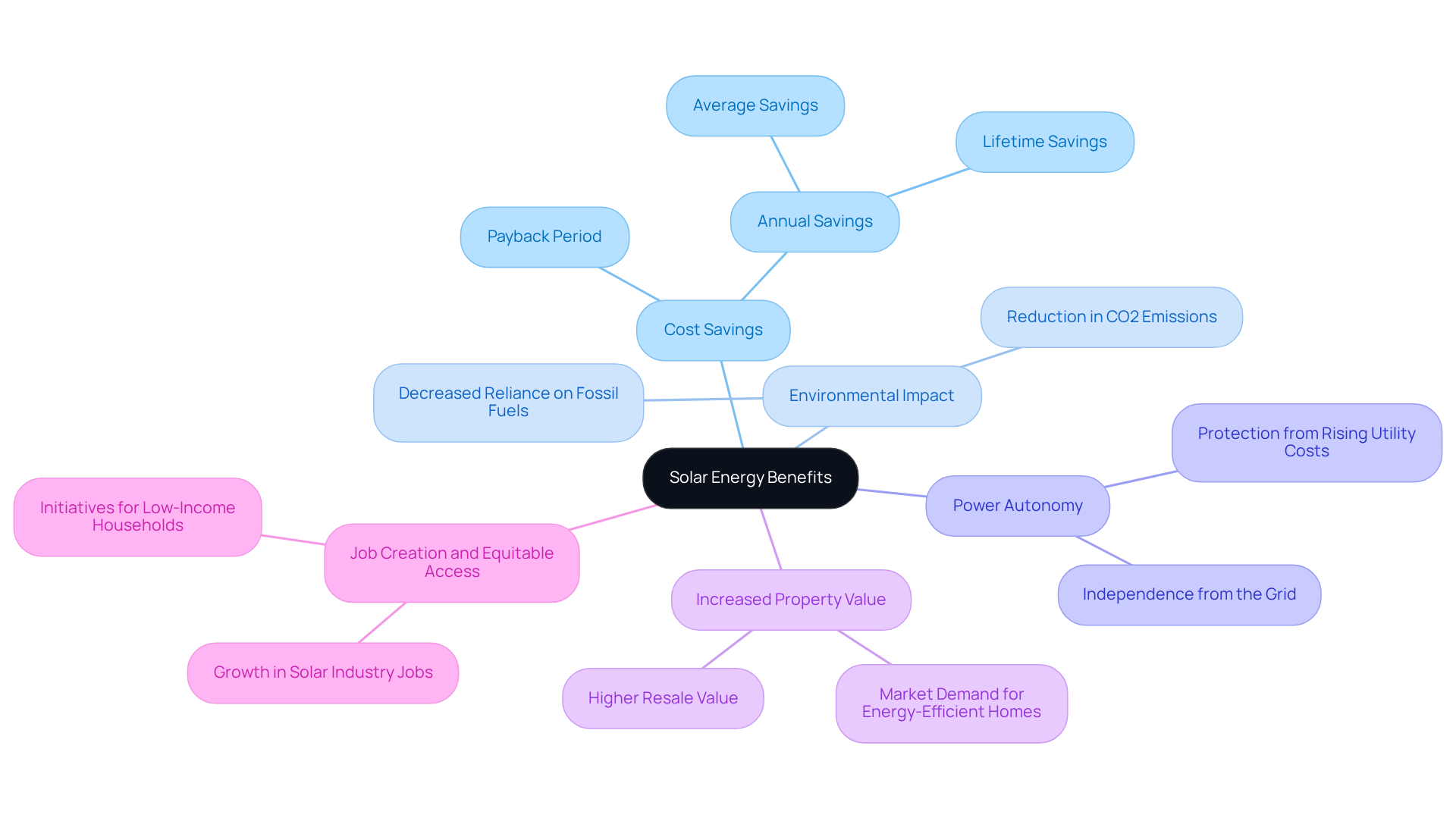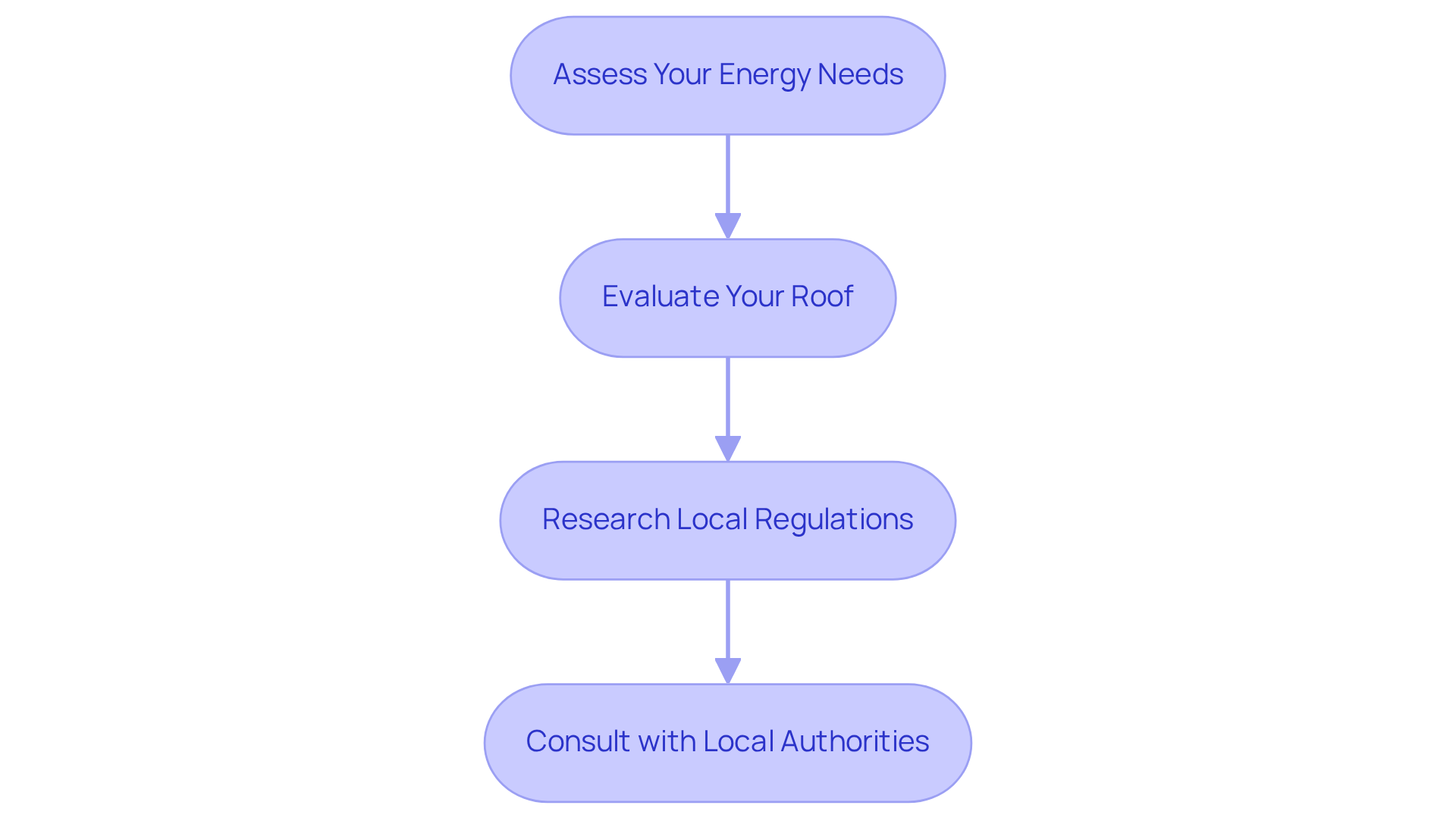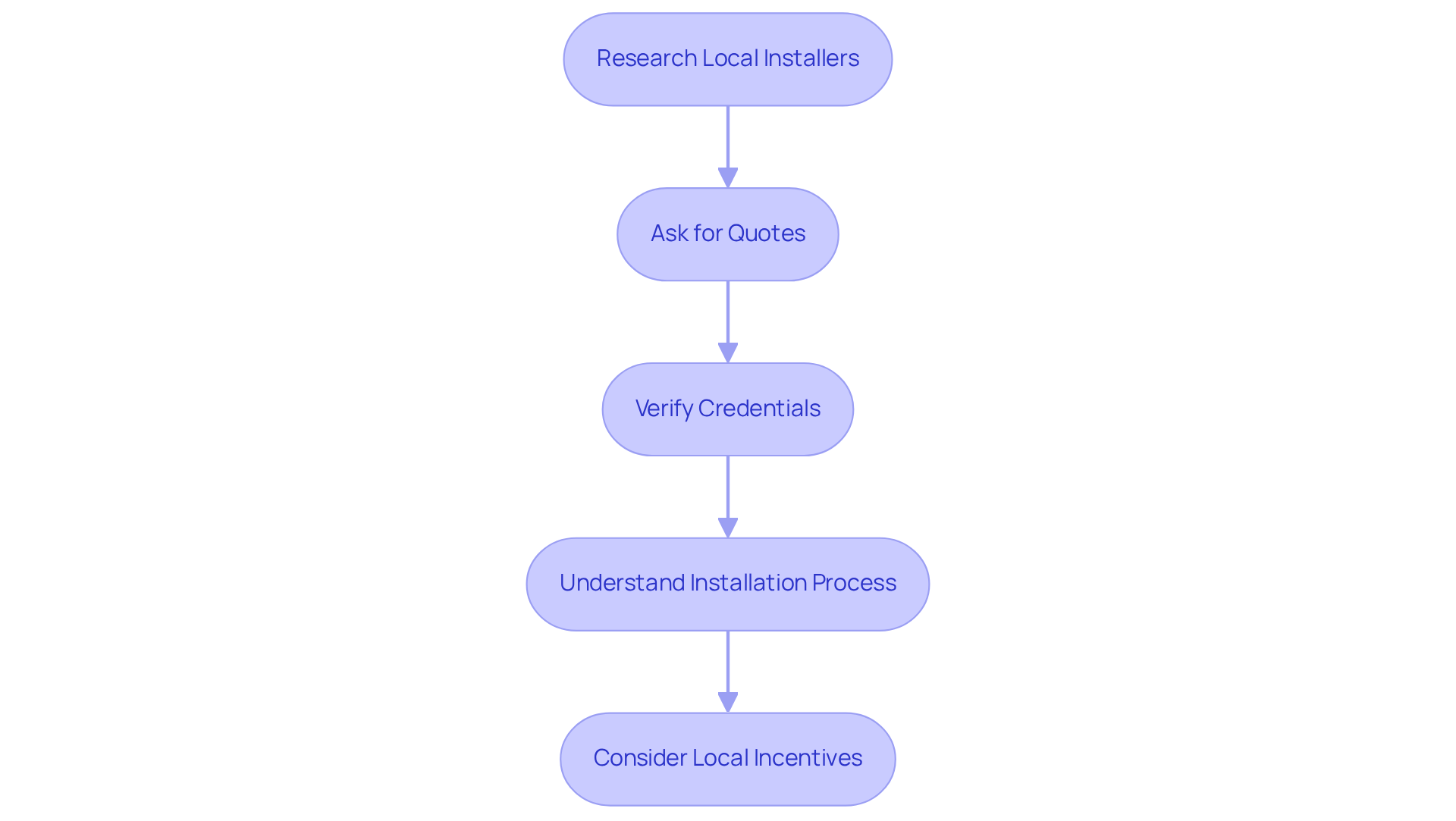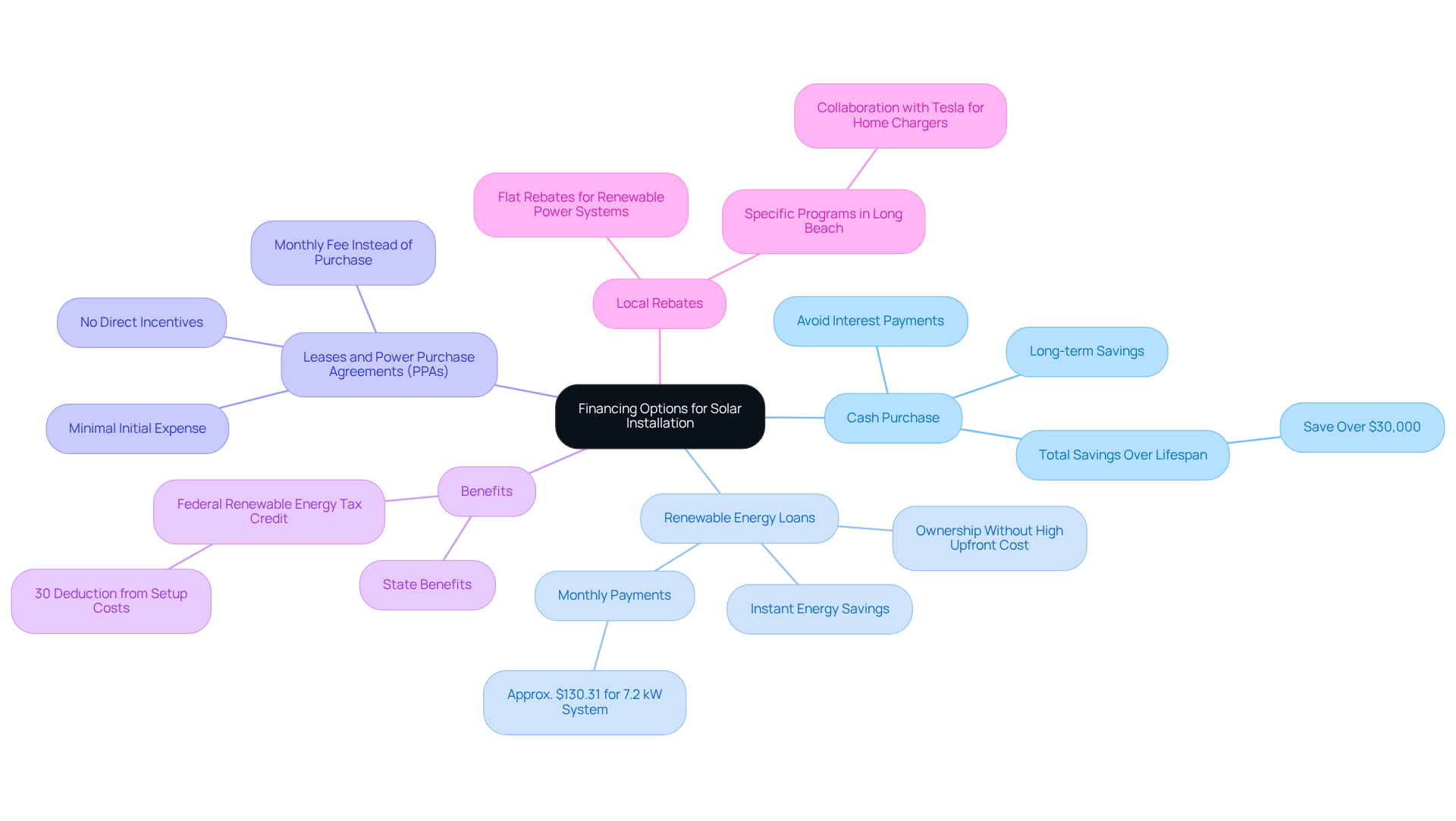Overview
Are you feeling overwhelmed by rising energy bills? You’re not alone. Many homeowners share this concern, and it’s completely understandable. Fortunately, there are steps you can take to regain control over your energy costs. The article outlines four essential steps for successful solar panel installation in Miami that can help you on this journey to energy independence.
-
First, it’s crucial to understand the benefits of solar energy. Not only can it lead to significant financial savings, but it also contributes to a sustainable future for our planet. By harnessing the power of the sun, you can reduce your reliance on traditional energy sources and take a meaningful step towards energy independence.
-
Next, preparing for installation is key. This involves assessing your energy needs and researching local regulations to ensure a smooth process. We understand that navigating these details can feel daunting, but with the right information, you’ll be well-equipped to make informed decisions.
-
Selecting a qualified installer is another vital step. This choice can significantly impact the quality and efficiency of your solar system. Look for professionals who have a proven track record and can provide references. Remember, together we can find the right partner to support you in this transition.
-
Lastly, exploring financing options is essential. There are various programs available that can make solar energy more accessible. Don’t hesitate to reach out for guidance on these opportunities.
By following these steps, you can embark on a path towards energy independence and financial savings. We’re here to support you every step of the way, ensuring that you feel confident and informed in your choices. Let’s work towards a brighter, more sustainable future together.
Introduction
As energy costs continue to rise, we understand that many homeowners in Miami are feeling the pressure. It’s common to wonder how to manage these escalating bills while also considering the impact on our environment.
Fortunately, solar power emerges as a sustainable solution that not only addresses financial concerns but also fosters energy independence and enhances property value. The benefits of solar energy extend beyond just financial savings; they encompass a significant positive environmental impact.
However, we recognize that embarking on the journey of solar panel installation can feel daunting. You might be asking yourself: what are the essential steps to ensure a successful transition to solar energy?
This guide is designed to break down the process into manageable steps, empowering you to navigate the complexities of installation, financing, and regulations with confidence. Together, we can maximize your investment in renewable energy and create a brighter, more sustainable future.
Understand Solar Energy Basics and Benefits
Are you feeling overwhelmed by rising energy bills? Solar energy harnesses sunlight to generate electricity through photovoltaic (PV) cells, providing a nurturing solution for homeowners looking for relief and sustainability.
- Cost Savings: Imagine the peace of mind that comes with substantial reductions in your electricity bills. Homeowners can save between $1,500 to $4,000 annually with solar panels. Over the lifespan of a photovoltaic panel system, which generally endures 25 to 30 years, total savings can vary from $20,000 to $96,000. This technology isn’t just a financial investment; it’s a step towards protecting yourself from the volatility of power costs and reducing dependence on fossil fuels.
- Environmental Impact: We understand how important it is to care for our planet. By harnessing solar energy, homeowners significantly decrease their reliance on fossil fuels, which helps reduce greenhouse gas emissions. In 2022 alone, photovoltaic panels offset over 140 million metric tons of CO2, contributing to a cleaner and healthier environment. Moreover, energy heating systems play a vital role in fostering a more sustainable future.
- Power Autonomy: Have you ever wished to produce your own electricity? Installing photovoltaic panels allows homeowners to do just that, decreasing reliance on the grid and shielding you from rising utility costs. This independence is increasingly important as electricity prices have risen by about 32% over the past decade. You’ll also find fulfillment in participating in the clean power initiative, effortlessly aligning your lifestyle with environmentally friendly practices.
- Increased Property Value: If you’re considering selling your home, know that houses fitted with renewable energy systems frequently experience a rise in property value. Research suggests that energy-efficient homes sell for 2.7% more than their less efficient counterparts, making solar-equipped homes more attractive to potential buyers.
- Job Creation and Equitable Access: Together, we can support the expansion of the renewable energy sector, which aids in job creation and offers numerous employment opportunities in setup, maintenance, and manufacturing. Initiatives like the Biden-Harris administration’s $7 billion Solar for All program seek to improve access to renewable energy, ensuring that the advantages of this technology are distributed fairly among various communities.
Grasping these advantages is essential for homeowners contemplating . By understanding these benefits, you lay the groundwork for a successful shift to sustainable power. Let’s work towards a brighter, cleaner future together.
Prepare for Installation: Assess Needs and Research Regulations
To ensure a successful solar panel installation in Miami, let’s explore some essential steps together:
- Assess Your Energy Needs: We understand that reviewing your electricity bills from the past year can feel overwhelming, but this step is crucial. By determining your average monthly usage, you can better comprehend the scale of the solar system needed to meet your power requirements.
- Evaluate Your Roof: It’s common to feel uncertain about your roof’s condition. Confirming that your roof is in good shape and receives adequate sunlight is vital. Ideally, south-facing roofs with minimal shading are best suited for photovoltaic panels, as they maximize energy absorption.
- Research Local Regulations: Familiarizing yourself with Miami’s building codes and zoning laws regarding solar setups can be daunting. However, compliance with regulations regarding Miami solar panel installation is essential, and understanding these regulations will empower you. The City of Miami’s permit catalog is a valuable resource that can guide you through these requirements.
- Consult with Local Authorities: Engaging with your local building department may seem like an extra step, but it’s a proactive strategy that can clarify any requirements or restrictions related to your setup. This approach will help you navigate the regulatory environment efficiently, ensuring a seamless installation process.
Together, we can work towards a that not only addresses your concerns but also empowers you with energy independence.
Select a Qualified Installer and Understand the Installation Process
Selecting a qualified installer for is a crucial step for homeowners aiming to reduce energy costs and adopt sustainable solutions. We understand that navigating this process can feel overwhelming, but by following these essential steps, you can make informed choices that lead to energy independence and financial savings.
-
Research local installers by identifying reputable firms for Miami solar panel installation in both Miami and Las Vegas. Look into their reviews, ratings, and industry experience to gauge customer satisfaction and reliability. When evaluating energy service providers, consider their offerings, warranties, and customer support to find the best value in energy solutions that align with your needs.
-
Ask for Quotes: It’s common to feel uncertain about pricing, so obtain quotes from multiple installers to compare services and costs. Ensure each quote includes a thorough analysis of expenses, as this can lead to savings of up to 20% compared to working with just one company. For example, homeowners can save approximately $66,759 over 25 years with a cash purchase of a 5 kW energy system thanks to Miami solar panel installation. Understanding that the average cost of Miami solar panel installation is around $2.38 per watt can provide valuable insights into potential savings when compared to traditional electricity.
-
Verify Credentials: Confirm that your chosen installer is licensed, insured, and holds certifications from recognized organizations. This step is crucial to ensure adherence to local regulations and standards, providing peace of mind for a successful setup.
-
Understand the Installation Process: Familiarizing yourself with the typical installation process can alleviate concerns. This includes:
- Site Assessment: The installer evaluates your property to determine the optimal system design based on roof orientation and size.
- Permitting: They will manage the necessary permits required by local authorities, which can be time-consuming but is essential for compliance.
- Setup: This phase involves the actual installation of solar panels, inverters, and other components, ensuring high-quality workmanship.
- Examination: After setup, a final examination is conducted to verify that everything meets local codes and safety standards.
Furthermore, considering local incentives and rebates, such as tax credits or utility discounts, can greatly lower setup expenses and enhance the overall value of your investment. For instance, some property owners may be eligible for a federal tax credit of 26% on their renewable energy system expenses. By following these steps, you can confidently navigate the Miami solar panel installation process and ensure a successful arrangement of energy panels that maximizes both financial and environmental advantages. Together, we can work towards a sustainable future.
Explore Financing Options and Incentives for Solar Installation
When considering Miami solar panel installation, we understand that many homeowners are concerned about rising energy bills. It’s essential to explore various financing options and incentives that can enhance your investment and lead you toward energy independence:
- Cash Purchase: Opting for a cash purchase allows you to save significantly in the long run by avoiding interest payments. Property owners who pay in advance can save more than $30,000 throughout the lifespan of their panels, as they remove dealer fees and interest expenses.
- Renewable Energy Loans: Numerous lenders offer financing tailored for energy installations, enabling you to distribute the expense over time while still benefiting from instant energy savings. In 2025, homeowners can anticipate paying approximately $130.31 each month for a renewable energy loan on a standard 7.2 kW system, which is frequently less than their existing electricity expenses. This financing option permits ownership without the strain of a significant initial expense.
- Leases and Power Purchase Agreements (PPAs): These arrangements allow you to install photovoltaic panels with minimal to no initial expense, paying a monthly fee instead. While this can make renewable energy more accessible, it’s important to note that you won’t receive since the energy company retains ownership of the panels.
- Benefits: Take full advantage of federal and state benefits, such as the federal renewable energy tax credit, which allows you to deduct 30% of your expenses related to the setup from your taxes in 2025. This notable decrease can render renewable power more economical and attractive.
- Local Rebates: Explore any local rebates or incentives provided by California that can further reduce your setup expenses. For example, certain regions offer flat rebates for renewable power systems, making the shift to alternative sources even more economically feasible. Furthermore, Long Beach tenants ought to investigate particular programs that might provide distinctive incentives for photovoltaic setups, including possible collaborations with Tesla for home chargers that can enhance renewable power solutions.
By understanding these financing options and incentives, you can make a more informed decision about your Miami solar panel installation, which will help maximize your savings and enhance your energy independence. Together, we can work towards a sustainable future that benefits both you and the environment.
Conclusion
Understanding the steps for successful Miami solar panel installation is essential for homeowners who are understandably concerned about rising energy bills and the impact on their finances. By harnessing the power of solar energy, you can not only contribute to environmental sustainability but also unlock significant financial savings and achieve energy independence. This guide emphasizes the importance of thorough preparation, informed decision-making, and leveraging available incentives to maximize the benefits of solar technology.
Key insights highlighted throughout this article include:
- The necessity of assessing your energy needs
- Evaluating roof conditions
- Familiarizing yourself with local regulations
- Selecting a qualified installer
- Exploring financing options
These steps can further ensure a smooth installation process and the realization of long-term savings. Additionally, understanding the environmental impact and the potential increase in your property value reinforces the advantages of adopting solar energy solutions.
As the shift towards renewable energy continues to gain momentum, we understand that taking the first step can feel daunting. However, by embracing solar technology, you can reduce your carbon footprint and lower energy costs while contributing to a sustainable future for our community. Engaging with local resources and incentives will pave the way for a successful transition to solar energy, making it a wise investment for both your personal and environmental well-being. Together, we can make a difference, and we are here to support you on this journey.






